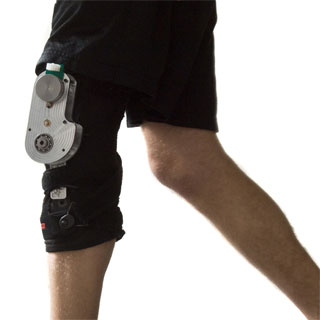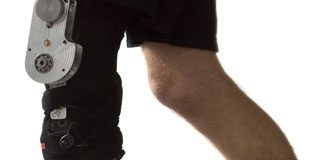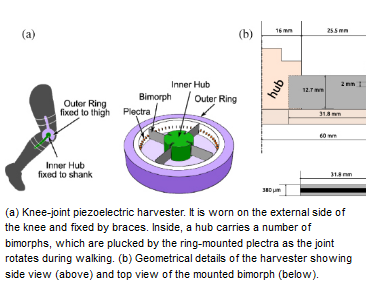
A biomechanical energy harvester that runs on knee power could replace our need for batteries that power our mobile devices.
Is this the beginning of the end for batteries?
Researchers in the UK have invented a power generating device that straps to your leg and harvests electricity through the motion of your knees. The biomechanical energy harvester could signal the eventual end of our dependence on batteries to power our mobile electronics, in addition to body monitoring gizmos such as heart monitors, pedometers, and accelerometers.
Besides having a huge potential for consumer markets, the energy harvester may find its way into the military, eliminating the need for British soldiers to load backpacks with 22 lbs of batteries.
This gadget debuted on June 15th, in the journal Smart Materials and Structures, submitted by researchers from Cranfield University, The University of Liverpool and University of Salford. Dr Michele Pozzi, lead author of the study, speculated that each unit might cost about $15 dollars each, once they reach mass production.
A rock star in the generation of renewable energy.
The energy harvesting device straps to the outside of the knee in the form of a circular shaped, aluminum housing that consists of an outer ring and central hub. The outer ring rotates as the knee joint goes through a walking motion.
The outer ring is fitted with 72 plectra, which act like tiny guitar picks that “pluck” four energy-generating arms (bimorphs) attached to the inner hub. When picks deflect off the bimorphic arms, they cause each one to vibrate like a guitar string, converting our mechanical activity to electrical energy.
It’s “Geek” to me, but I’m looking at the future of mobile electronics and sustainable energy.
“A bimorph is a type of piezoelectric device capable of converting mechanical energy, such as the vibrating caused by the plectra, into electrical energy, and vice versa.”
“Piezoelectric materials have long been used as sensors in SONAR and ultrasound scanners and have recently been the focus of attention in the field of energy harvesting,” said lead author of the study Dr Michele Pozzi.
Currently, the knee-joint piezoelectric harvester produces two milliwatts of power. Researchers believe that additional improvements could boost levels beyond 30 milliwatts of juice, which could allow for a new generation of GPS tracking devices, more advanced signal processing, along with more frequent and longer wireless transmission.
Don’t start dreaming of blow drying your hair atop Mt. Everest just yet. Power-hungry smart phones and equally demanding digital devices will make short work of 30 milliwatts. But we see a bright future for a green technology destined to gain momentum and muscle, strapped to environmentally conscious consumers.








